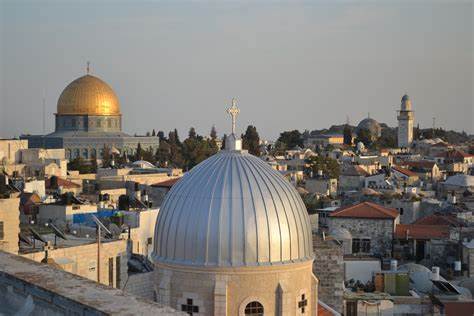Saturday we took a rest day. I wrote an article for Imaginative Conservative and a draft script for the filming we plan to do in England in June. Elias chilled out and visited the Citadel of David near the Jaffa Gate.
On Sunday morning after a quick breakfast we hiked over to the Old City to attend Mass celebrated in the Byzantine Rite at the Greek Catholic (Melkite) Cathedral of the Annunciation. I had learned to celebrate the Maronite Liturgy in Greenville, so things were easy enough to understand, and they had English versions of the liturgy available for us–although the liturgy was in Arabic.
What I loved about attending the Byzantine Rite was the realization that this liturgy not only traces its roots back to the fourth century, but I loved noting the similarities to the Latin Rite–and yes–even to the bare bones of the Novus Order.
I am, by no means a liturgiologist or an expert in the history and development of the liturgy. Those who have read this blog for any amount of time will know I am a traditional priest, but not a traditionalist. In other words, I am in favor of a traditional, reverent celebration of the Novus Ordo–while having huge respect for the Traditional Latin Mass and the various Eastern Rites.
If only our modern Latin Rite Novus Ordo priests would listen and learn from the traditionalists and Eastern Rite Catholics! The Byzantine Mass we attended today was accessible, reverent, holy and deeply traditional. There was great participation from the people, while their reverence and simple worship was beautiful to see.
The other thing that impressed me about the Byzantine Mass was that clearly, all our mass celebrations are influenced by our culture. The Byzantine Mass in Jerusalem celebrated in Arabic was MiddleEastern 21st century–while at the same time being rooted in the fourth c. Likewise, we should not be surprised when a Mass in Nigeria is Nigerian and from the 21st c. Similarly, our American Novus Ordo Masses reflect our culture and time. To my mind there is nothing wrong with this. It shows the flexibility and adaptability of our Catholic faith.
However, while this cultural adaptability is fine, if if strays too far from the tradition it becomes rootless and irrelevant–and this is the irony: the more a modernist Western priest attempts to make the Mass of the Ages relevant the more irrelevant it becomes. It’s like dressing up the queen of England as Marilyn Monroe in order to make her more sexy. You end up destroying HMQ and Marilyn.
So let’s avoid the stupidity of turning the Mass into an entertainment in which the priest, like some talk show host, begins the show with an amusing monologue. But likewise, let’s avoid turning the Mass into some kind of purist museum piece in which an archaic, ossified liturgy is venerated for its own sake rather than the means by which we worship God and share in his divinity.
The Introduction in the English Mass booklet we were given this morning reminded us that the liturgy is “Heaven on earth”. The architecture and iconography certainly made that real–and the worship and words moved us up Jacob’s Ladder with the angels. Here was Bethel–the threshold of heaven–here in the Old City of Jerusalem just a few hundred yards from Calvary and the empty tomb.
Today is May 1- the beginning of Mary’s month. I always enjoy this poem of Gerard Manley Hopkins on May Day:
For the remainder of my Jerusalem Diary posts and pictures on Twitter I am going to try to focus on Mary here in the Holy Land. I hope you enjoy them.







Leave A Comment
You must be logged in to post a comment.